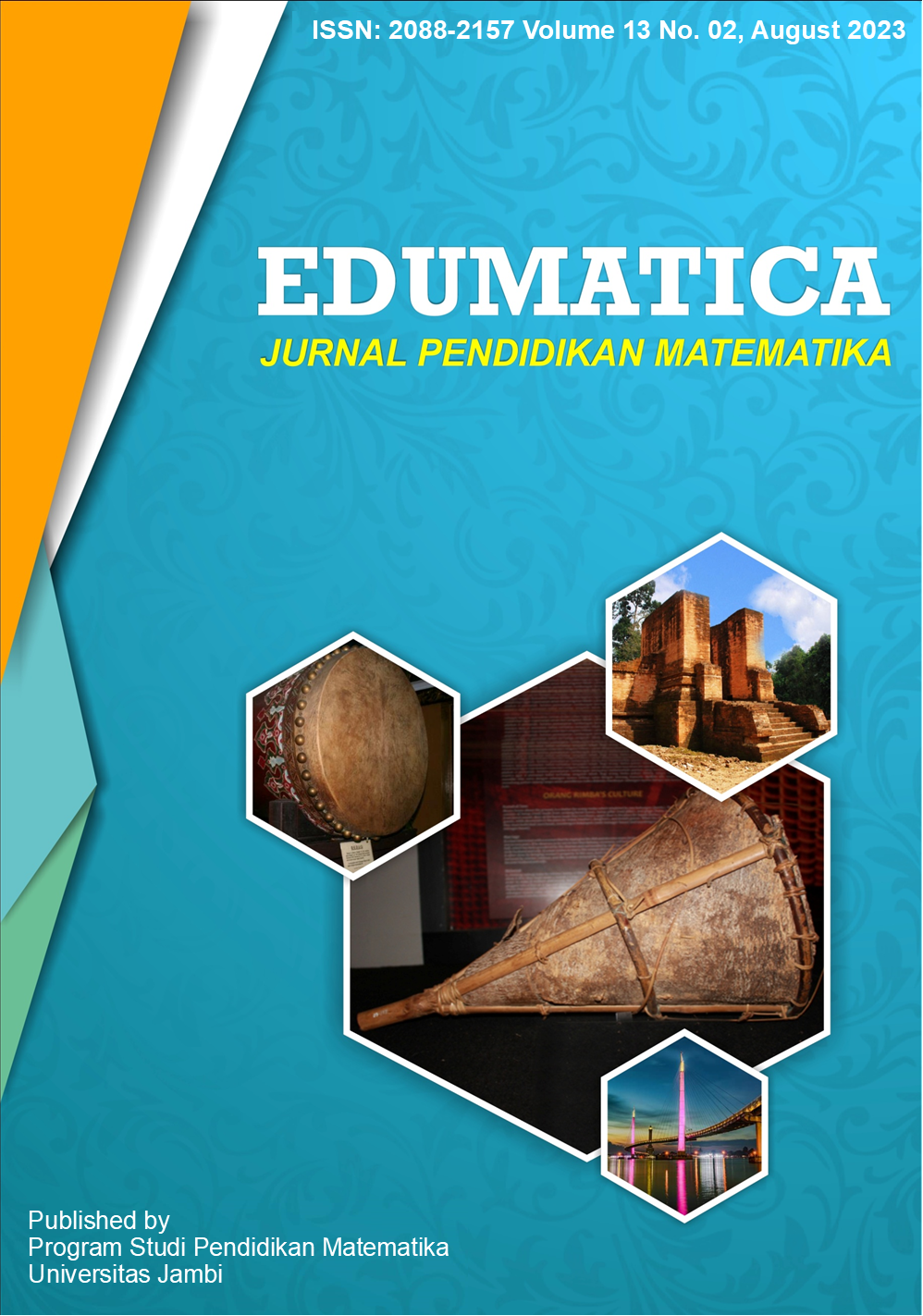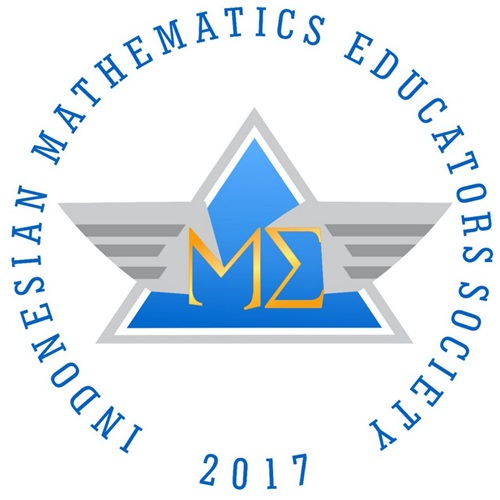Numeracy Abilities of Reflective and Impulsive Cognitive Style Students in Solving SPLDV Problems
DOI:
https://doi.org/10.22437/edumatica.v13i02.25998Keywords:
impulsive cognitive style, numeracy abilities, reflective style, SPLDVAbstract
Numerical ability is an important ability for students to have. This study aims to analyze students’ numeracy abilities in the matter of a two-variable linear education system (SPLDV) in terms of reflective and impulsive cognitive styles, so that the research approach used is qualitative with a descriptive type of research. This study's subjects were four students divided into two reflective students and two impulsive students. The data collection technique used is the Matching Familiar Figure Test (MFFT), a numeracy skills test, interviews, and documentation. The results showed that subjects with a reflective cognitive style were able to fulfill 4 numeric indicators (understanding problems, designing problem solutions, implementing strategies, and re-examining). given has a relatively small tendency to be wrong. Whereas subjects with an impulsive cognitive style can answer all questions but only fulfill 2 numeration indicators (understanding problems and designing problem solutions), and require a fast time to solve questions, so the answers given have a relatively large tendency to be wrong.
Downloads
References
Andriani, P. (2015). Penalaran Aljabar dalam Pembelajaran Matematika. Beta: Jurnal Tadris Matematika, 8(1), 1-13.
Aprilia, N. C., Sunardi, S., & Trapsilasiwi, D. (2017). Proses Berpikir Siswa Gaya Kognitif Reflektif dan Impulsif dalam Memecahkan Masalah Matematika di Kelas VII SMPN 11 Jember. Jurnal Edukasi, 2(3), 31. https://doi.org/10.19184/jukasi.v2i3.6049
Bachri, B. S. (2010). Meyakinkan Validitas Data Melalui Triangulasi Pada Penelitian Kualitatif. Teknologi Pendidikan, 10(1), 46-62.
Delima, N., Kurniasih, I., Tohari, Hutneriana, R., Amalia, F. N., & Arumanegara, E. (2022). PISA DAN AKM Literasi Matematika dan Kompetensi Numerasi (N. Delima, Ed.). Subang: Unsub Press.
Fakhriyana, D., Mardiyana, & Aryuna, D. R. (2018). Analisis Kemampuan Literasi Matematika dalam Memecahkan Masalah Model Programme For International Student Assessment (PISA) pada Konten Perubahan dan Hubungan Ditinjau dari Kecerdasan Logis Matematis Siswa Kelas IX SMP Muhammadiyah Program Khusus Surakart. Jurnal Pendidikan Matematika Dan Matematika, 2(6), 421-434.
Galante, D. (2014). The Use of the History of Mathematics in the Teaching of Preservice Teachers. Redimat, 3(2), 110-120. https://doi.org/10.4471/redimat.2014.45
GLN. (2017). Materi Pendukung Literasi Numerasi. In Kementrian Pendidikan dan Kebudayaan. Jakarta.
Kemdikbud, P. (2019). Pendidikan di Indonesia belajar dari hasil PISA 2018. In Pusat Penilaian Pendidikan Balitbang KEMENDIKBUD. Jakarta: Puspendik Kemdikbud.
Kemendikbudristek. (2021). Modul Literasi Numerasi Di Sekolah Dasar. 1, 22.
Kurniawan, L., & Munandar, D. R. (2022). Kemampuan Literasi Numerasi pada Materi Persamaan SPLDV Siswa SMP. Sesiomadika, 4(1), 340-345.
Mailili, W. H. (2018). Deskripsi Hasil Belajar Matematika Siswa Gaya Kognitif Field Independent dan Field Dependent. ANARGYA: Jurnal Ilmiah Pendidikan Matematika, 1(1), 1-7. https://doi.org/10.24176/anargya.v1i1.2371
Nasoha, S. R., Araiku, J., Pratiwi, W. D., & Yusup, M. (2022). Kemampuan Numerasi Siswa Melalui Implementasi Bahan Ajar Matematika Berbasis Problem Based Learning. Indiktika : Jurnal Inovasi Pendidikan Matematika, 4(2), 49. https://doi.org/10.31851/indiktika.v4i2.7903
NCTM. (2000). Principles and Standards for School Mathematics. United States of America: The National Council of Teachers of Mathematics. Inc. Retrieved from www.nctm.org
OECD. (2019). PISA 2018 Assessment and Analytical Framework. Paris: OECD Publlishing.
Ojose, B. (2011). Mathematics literacy : are we able to put the mathematics we learn into everyday use? Journal of Mathematics Education.
Patta, R., Muin, A., & Mujahidah, M. (2021). Kemampuan Literasi Numerasi Ditinjau dari gaya Kognitif Reflektif-Impulsif. JIKAP PGSD: Jurnal Ilmiah Ilmu Kependidikan, 5(2), 212. https://doi.org/10.26858/jkp.v5i2.20130
Pramastasari, A. E. (2017). Scaffolding untuk Membantu Komunikasi Matematis Siswa Bergaya Kognitif Reflektif dalam Menyelesaikan Soal Open-Ended. Program Pascasarjana Universitas Negeri Malang.
Purpura, D. J. (2009). Informal Number-Related Mathematics Skills: An Examination of the Structure of and Relations Between these Skills in Preschool. Journal of Experimental Child Psychology.
Rahmat, P. S. (2009). Penelitian Kualitatif. EQUILIBRIUM, 5(9), 1-8. https://doi.org/10.31227/osf.io/wtncz
Sari, R. H. N., & Wijaya, A. (2017). Mathematical literacy of senior high school students in Yogyakarta. Jurnal Riset Pendidikan Matematika, 4(1), 100-107. https://doi.org/10.21831/jrpm.v4i1.10649
Sternberg, R. J., & Grigorenko, E. L. (1997). Are cognitive styles still in style? American Psychologist, 52(7), 700-712. https://doi.org/10.1037/0003-066X.52.7.700
Warli. (2010). Profil Kreativitas Siswa yang Bergaya Kognitif Reflektif dan Siswa yang Bergaya Kognitif Impulsif dalam Memecahkan Masalah Geometri. Program Pascasarjana UNESA.
Warli. (2013). Kreativitas Siswa SMP yang Bergaya Kognitif Re! ektif atau Impulsif dalam Memecahkan Masalah Geometri. Jurnal Pendidikan Dan Pembelajaran, 20(2), 190-201.
Yuliyani, D. R., & Setyaningsih, N. (2022). Kemampuan Literasi Matematika dalam Menyelesaikan Soal Berbasis PISA Konten Change and Relationship Ditinjau dari Gaya Kognitif Siswa. Edukatif : Jurnal Ilmu Pendidikan, 4(2), 1836-1849. https://doi.org/10.31004/edukatif.v4i2.2067
Downloads
Published
How to Cite
Issue
Section
License
Copyright (c) 2023 Nikita Dewi, Esti Ambar Nugraheni

This work is licensed under a Creative Commons Attribution-NonCommercial-ShareAlike 4.0 International License.







